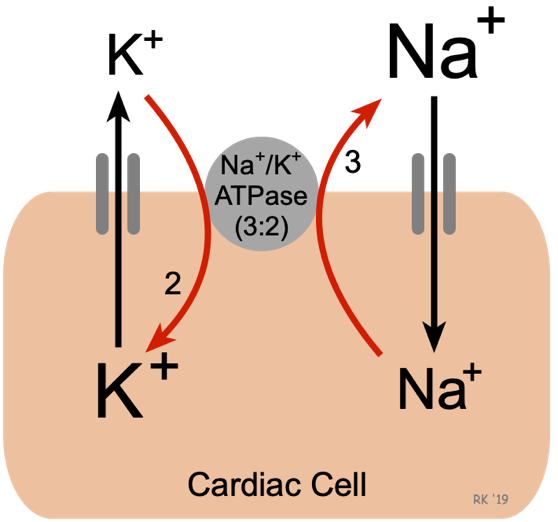22A02: Exam Report
Explain the mechanisms of transport of substances across cell membranes including appropriate examples (75% marks). Outline the structure and function of the Na+/K+-ATPase pump (25% marks)
61% of candidates passed this question.
This question examined core cellular physiology knowledge. This knowledge is crucial as it underpins much of the electrochemical responses within the syllabus. Mechanisms of diffusion and the role of individual pathways were well presented in many responses.
Answers that scored well generally classified the mechanisms of transport into active and passive processes which ensured an appropriate breadth of answer.
Many answers failed to provide any examples which was requested. The structure of the Na+/K+ ATPase pump was less well described, however pleasingly most candidates were able to accurately articulate its role and function.
Eii / 22A02: Explain the mechanisms of transport of substances across cell membranes including appropriate examples (75% marks). Outline the structure and function of the Na+/K+-ATPase pump (25% marks)
Mechanisms of transport across cell membranes
Diffusion
Is the passive movement of a substance down its concentration gradient across the cell membrane
Simple passive diffusion
- Dissolution in lipid bilayer (e.g. CO2)
- Lipid soluble unionised substances. Rate of transfer depends on pKa
- Via protein channels
- Leak channels (always open) (e.g. K+ leak channels)
- Voltage-gated channels (e.g. L-type Ca2+ channel)
- Ligand-gated channels (e.g. nicotinic acetylcholine receptor)
- Mechanically-gated channels (e.g. arteriolar smooth muscle stretch receptors)
Facilitated diffusion
- Requires interaction between substance and carrier protein
- Eg. glucose via GLUT1-5 transporters
Active transport
Is the movement of substance against its concentration gradient across the cell membrane using energy
Primary active transport
- Is the energy derived from hydrolysis of ATP
- Eg. Na+/K+ ATPase
Secondary active transport
- Is the energy derived indirectly by coupling pump action with actively maintained ion gradient
- Eg. co-transport of Na+ and glucose via sodium-glucose-linked transporter 2
Endocytosis
Is the energy consuming process where large substances are enveloped in a portion of the cell membrane -> vesicles
- Eg. vitamin B12-intrinsic factor complex through enterocytes of terminal ileum
- Exocytosis: reverse of endocytosis out of cell
- Transcytosis: passing through cell by endo and exocytosis
Na+/K+ ATPase PUMP

- Membrane-bound protein pump that exchanges Na+ for K+ by primary active transport, consuming ATP
- Structure: large α subunit (contains ATPase) and smaller β subunit
- 3 Na+ moved extracellularly for 2K+ moved intracellularly
- Stimulated by Na+ and K+ concentrations
Electrogenic: results in small negative intracellular charge
Role
Is the generation of Na+ and K+ concentration gradients
Resting membrane potential
- Small direct contribution by negative intracellular charge generated from unequal transport of Na+ and K+
- Established concentration gradients responsible for high intracellular K+ ultimately enable generation of RMP
Cell volume
- Osmotic effect of high extracellular Na+ balances osmotic effect of negative intracellular proteins
- Failure of Na+ K ATPase causes cell to swell
Transport
- Provides driving force for many secondary active transporters (e.g. Na+/Ca2+ exchanger in myocytes for lusitropy)
Neuronal activity
- Depolarisation of nerves to generate action potentials depends on Na+ gradient
Signal transduction
Author: Emily Little